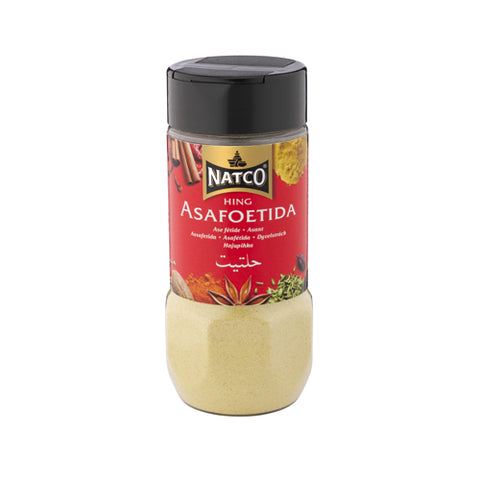What is Asafoetida Powder?

Asafoetida powder is a spice that has been a staple in Indian cuisine for centuries, known for its aroma.
Asafoetida, known also as 'hing' or 'heeng', is an intensely aromatic spice derived from the dried gum resin of various plants in the giant fennel family.
This spice plays a vital role in Indian cuisine, having been introduced through the Moghul empire. Its name is rooted in Persian, where "aza" means resin, and the Latin, "foetida" which translates to stinking/fetid. Hinting at its potent and unique smell.
Ground asafoetida has a particularly strong fragrance, reminiscent of garlic. When cooked, it emits an aroma similar to onions. It is especially favored by the Brahmin and Jain communities, who avoid garlic and onions in their dishes.
In traditional Indian cooking, asafoetida is usually sautéed first to temper its intense flavor, rather than being added directly.
Due to its robustness, it should be used sparingly in recipes like chat masala, pickles, and dals. For a great recipe, consider trying Dahi ni Kadhi.
Introduction to Asafoetida
What is Asafoetida Powder?
Asafoetida powder, often known as “hing” in Indian households, is derived from a resin obtained from the roots of giant fennel plants, specifically a species called Ferula. These plants are native to regions like Iran and Afghanistan.
The resin is dried and ground into a fine powder, which is then used as a spice. Despite its pungent, somewhat unpleasant odour in its raw form, the powder mellows out when cooked, imparting a smooth, savoury taste reminiscent of leeks or garlic. This transformation makes it an essential ingredient in many vegetarian and lentil-based dishes.
History and Origin
The history of asafoetida dates back to ancient Persia, where it was first used for its medicinal properties. The resin was traded along the Silk Road and eventually made its way to India, where it became a culinary staple.
Asafoetida can open up a world of Indian cooking possibilities, including making saag paneer, soups, stews, curries, and other Indian dishes. Its use is documented in ancient Sanskrit texts, which highlight its significance in both traditional medicine and cooking.
Known as “hing” in Sanskrit, asafoetida was revered for its ability to balance various doshas in Ayurvedic medicine. Over time, it became an indispensable spice in Indian vegetarian cuisine, particularly in dishes that avoid onions and garlic.
Common Names and Varieties
Asafoetida is known by various names across different cultures and regions. In India, it is commonly referred to as "hing." The spice is also known as "food of the gods" in some ancient texts, despite its strong initial odour.
There are primarily two main varieties of asafoetida: Ferula asafoetida and Ferula narthex. The former is more commonly used and is considered of higher quality. Additionally, asafoetida comes in two forms: pure resin and compounded powder.
The pure resin is more potent and requires careful handling, while the compounded powder is blended with rice flour or gum Arabic to make it easier to use in cooking. Understanding these varieties and names can help you choose the right type for your culinary needs, ensuring you get the most out of this unique spice.
How to Use Asafoetida
Enhancing Flavours in Cooking
Asafoetida powder is a powerful flavour enhancer, particularly in vegetarian and vegan dishes. When added to hot oil or ghee, its initial pungency dissipates, leaving a rich, aromatic flavour similar to onions or garlic.
This makes it an excellent substitute for those who avoid these ingredients for dietary or religious reasons. Asafoetida is often used in lentil dishes, curries, and pickles. Just a pinch can elevate the overall taste, adding depth and umami.
It pairs well with turmeric, cumin, coriander, coriander seeds, and cumin seeds, making it a versatile addition to spice blends. Its ability to enhance and harmonise flavours without overwhelming them is why asafoetida is considered a secret weapon in many kitchens.
Indian Dishes With Asafoetida
Asafoetida is a key ingredient in many dishes across Indian cuisine. One popular dish is “Dal Tadka,” a spiced lentil soup that relies on asafoetida to enhance its savoury notes.
Another favourite is “Sambar,” a South Indian lentil stew loaded with vegetables, where a pinch of asafoetida adds depth to its complex flavour profile. “Chana Masala,” a chickpea curry, also benefits from the addition of this spice, bringing out the earthy flavours of the legumes.
In North India, asafoetida is often used in “Aloo Gobi,” a spiced potato and cauliflower dish. Beyond these, it is also a crucial component in various pickles and chutneys, adding a unique tang.
Substitutes and Alternatives for Asafoetida
If you find yourself without asafoetida powder, there are several substitutes that can mimic its flavour, albeit not perfectly. A common alternative is a mixture of garlic and onion powder, which can provide a similar umami profile.
Another option is leek powder, which offers a comparable depth of flavour. For those who prefer whole ingredients, finely minced garlic and shallots can also serve as substitutes, especially when sautéed in oil to release their flavours.
However, it's important to note that these alternatives may not replicate the exact taste and aroma of asafoetida. They can, nonetheless, serve as a temporary solution. Understanding these substitutes ensures you can still achieve a flavourful dish even when asafoetida is not available.
Shop Indian food & ingredients
Other Medicinal Uses of Asafoetida
Beyond its digestive and anti-inflammatory benefits, asafoetida has been heralded for a range of other medicinal uses. It has been traditionally employed as a remedy for respiratory conditions, thanks to its expectorant properties, which are thought to help clear mucus from the airways.
Asafoetida is also known to possess antimicrobial and antiviral effects, making it useful in combating infections and boosting immunity. Additionally, the spice has been used to relieve menstrual pain and regulate menstrual cycles, offering a natural alternative to conventional pain relief methods.
How to Store and Use Asafoetida
Proper Storage Techniques in an Airtight Container
Asafoetida powder should be stored in an airtight container, preferably made of glass, to keep its aroma from changing the smell of other ingredients.
Ensure the container is in a cool, dry place away from direct sunlight and moisture, as these can degrade the spice’s quality.
Common Mistakes to Avoid
When using asafoetida, there are several common mistakes to watch out for. First, avoid using too much of the spice. Its potent flavour can easily overpower a dish, turning it unpleasantly bitter.
Stick to the recommended dosage, usually just a pinch or 1/8th of a teaspoon. Another mistake is adding asafoetida too late in the cooking process. It’s essential to add it to hot oil or ghee at the beginning to mellow its strong aroma and fully develop its flavour.
Storing asafoetida improperly is another frequent error. Ensure it is kept in an airtight container to prevent its strong odour from contaminating other spices and foods. Lastly, avoid handling asafoetida with wet utensils, as moisture can cause it to clump and spoil.
By steering clear of these common pitfalls, you can make the most of asafoetida’s unique properties and enhance your culinary creations effectively.



